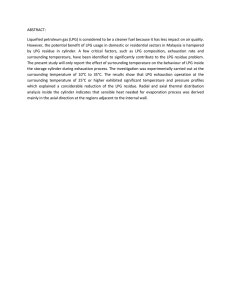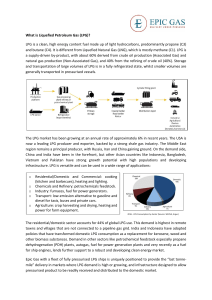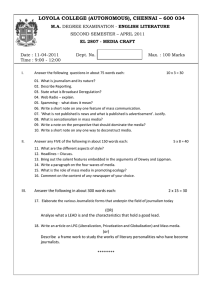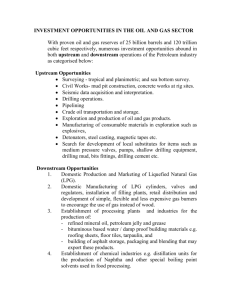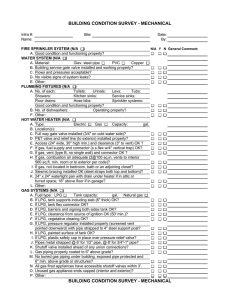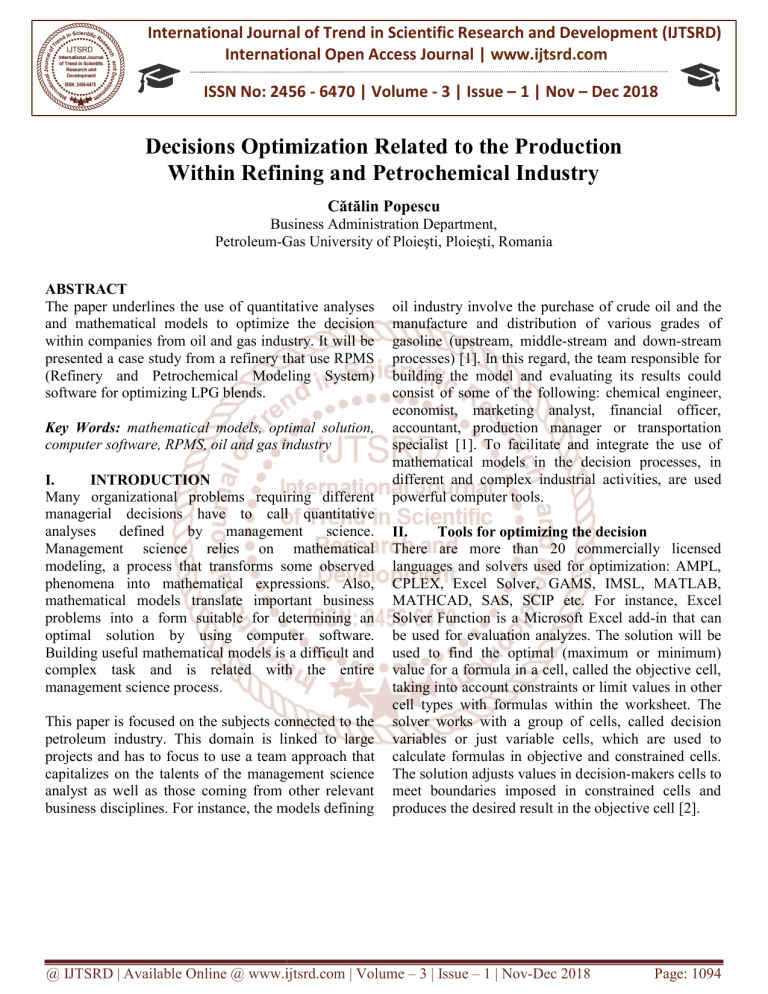
International Journal of Trend in Scientific Research and Development (IJTSRD)
International Open Access Journal | www.ijtsrd.com
ISSN No: 2456 - 6470 | Volume - 3 | Issue – 1 | Nov – Dec 2018
Decisions Optimization Related to the Production
Within Refining aand
nd Petrochemical Industry
Cătălin Popescu
Business Administration Department,
Petroleum-Gas
Gas University of Ploieşti, Ploieşti, Romania
ABSTRACT
The paper underlines the use of quantitat
quantitative analyses
and mathematical models to optimize the decision
within companies from oil and gas industry. It will be
presented a case study from a refinery that use RPMS
(Refinery and Petrochemical Modeling System)
software for optimizing LPG blends.
Key Words: mathematical models, optimal solution,
computer software, RPMS, oil and gas industry
I.
INTRODUCTION
Many organizational problems requiring different
managerial decisions have to call quantitative
analyses
defined
by
management
science.
Management science
ence relies on mathematical
modeling, a process that transforms some observed
phenomena into mathematical expressions. Also,
mathematical models translate important business
problems into a form suitable for determining an
optimal solution by using compute
computer software.
Building useful mathematical models is a difficult and
complex task and is related with the entire
management science process.
This paper is focused on the subjects connected to the
petroleum industry. This domain is linked to large
projects and has to focus to use a team approach that
capitalizes on the talents of the management science
analyst as well as those coming from other relevant
business disciplines. For instance, the models defining
oil industry involve the purchase of crude oil and the
manufacture and distribution of various grades of
gasoline (upstream, middle-stream
stream and down-stream
down
processes) [1]. In this regard, the team responsible for
building the model and evaluating its results could
consist of some of the following: chemical
chem
engineer,
economist, marketing analyst, financial officer,
accountant, production manager or transportation
specialist [1]. To facilitate and integrate the use of
mathematical models in the decision processes, in
different and complex industrial activities,
acti
are used
powerful computer tools.
II.
Tools for optimizing the decision
There are more than 20 commercially licensed
languages and solvers used for optimization: AMPL,
CPLEX, Excel Solver, GAMS, IMSL, MATLAB,
MATHCAD, SAS, SCIP etc. For instance, Excel
Exce
Solver Function is a Microsoft Excel add-in
add that can
be used for evaluation analyzes. The solution will be
used to find the optimal (maximum or minimum)
value for a formula in a cell, called the objective cell,
taking into account constraints or limit values
va
in other
cell types with formulas within the worksheet. The
solver works with a group of cells, called decision
variables or just variable cells, which are used to
calculate formulas in objective and constrained cells.
The solution adjusts values in decision-makers
d
cells to
meet boundaries imposed in constrained cells and
produces the desired result in the objective cell [2].
@ IJTSRD | Available Online @ www.ijtsrd.com | Volume – 3 | Issue – 1 | Nov-Dec
Dec 2018
Page: 1094
International Journal of Trend in Scientific Research and Development (IJTSRD) ISSN: 2456-6470
2456
Fig.1 Set parameters in Excel Solver Function (capture from Microsoft Excel 2016)
The solver methods used by Solver are as follows:
1. Generalized Reduced Gradient (GRG) Nonlinear
is used for non-linear problems;
2. Linear Programming Simplex is used for linear
problems;
3. Evolutionary is used for strong non
non-linear issues
[2].
Another example is represented by FICO Xpress
Optimization. The broad portfolio of FICO Xpress
Optimization, in terms of optimization options, allows
users to build, place and use optimization solutions
that meet the requirements. The standard package
includes performance solvers and algorithms, flexible
modelingg environments, fast application development,
comparative scenario study and reporting capabilities
and cloud installations. Solving a wide range of issues
may be the difference between success and failure in
today's market environment. FICO® Xpress
Optimization
zation allows companies to solve their most
difficult problems faster. Xpress Optimization
consists of four components:
1. FICO Xpress Insight enables companies to
quickly implement optimization models as
powerful applications. This allows companies and
other users to work with patterns in easy-toeasy
understand terms;
2. FICO Xpress Executor provides independent
support for execution optimization services,
enabling companies to deploy and run
optimization models quickly and easily;
3. FICO Xpress Solver offers the widest
wide range of
industry-leading
leading optimization algorithms and
technologies to solve linear, mixed and nonlinear
numerical problems;
4. FICO Xpress Workbench is an integrated
development
environment
for
developing
optimization models, services and solutions.
@ IJTSRD | Available Online @ www.ijtsrd.com | Volume – 3 | Issue – 1 | Nov-Dec
Dec 2018
Page: 1095
International Journal of Trend in Scientific Research and Development (IJTSRD) ISSN: 2456-6470
2456
FICO® Xpress Workbench supports and is used
with all other FICO Xpress Optimization
components [3].
III.
Case study regarding the Implementation of
RMPS software for optimizing LPG blends
The RPMS software is used for strategic (long
(long-term),
medium and current (short term) planning. The
recursive linear sequential programming (LP)
recursive method is used to search for the solution of
optimized production planning problems in RPMS
systems [4]. To make the decision known to other
organizational structures involved in the production
process, economic and logistic analysis, RPMS
generates a series of .xls (EXCEL) reports. In order to
control the fulfillment of the production plan at least
once a week, a meeting will be held with the staff
involved in production and delivery
deliv
management.
The demand for liquefied petroleum gas (LPG) is
strongly influenced by the market price of gasoline
(the LPG car being the alternative to gasoline for
internal combustion engines adapted to the use of
LPG) and has a pronounced seasonal character,
cha
so in
the summer period the demand for LPG increases and
decreases during the winter period[5]. The refinery
produces 3 types of liquefied petroleum gas (LPG):
automotive LPG, LPG type 3 and propylene, based on
4 components: propane, propylene, propanepro
butane
and butane. The properties of the LPG components
and their specifications are presented in Tables I and
II [6].
TABLE I LPG components and properties
Properties %gr
Flow
Production, t
C2, %gr C3, %gr C4, %gr C5, %gr Total, %gr C3´, %gr
Propane
3000
2%
96%
2%
0%
100%
4%
Propylene
4000
1%
97%
2%
0%
100%
96%
Propane-butane
800
1%
40%
58%
1%
100%
0%
Butane
12200
0%
3%
95%
2%
100%
2%
TOTAL
20000
TABLE II Specifications for LPG for cars, LPG type 3 and propylene
LPG for ca
cars
LPG type 3
Propylene
Component
min %gr max %gr min %gr max %gr min %gr max %gr
C2
1%
1%
C3
36%
35%
C4
60%
C5
2%
3%
C3’
12%
35%
95%
Depending on the market demand and the season, the price of liquefied petroleum gas may vary. In the absence
ab
of logistical and production limitations, the refinery will maximize production of one of three types of LPG
products at the expense of other types to maximize the profit.
In the following, it will be analyzed situations in which the price of one of the types of LPG products changes
from one another, thus influencing the decision to add propylene to the LPG auto in order to optimize LPG
mixtures. Changing the price of one of the practical components will result in two mixes of the three LPG
products:
1. The content of propylene in the LPG for cars will be minimal;
2. The propylene content in the automotive LPG will be maximum (max 12% according to the specification in
table II).
Case 1 assumes that the sale of propylene as a separate product without additi
additive
ve in the LPG for cars will result
in a maximum profit. In tables III to V, are presented the simulation results in the RPMS of Case 1, starting
from the data in tables I and II.
@ IJTSRD | Available Online @ www.ijtsrd.com | Volume – 3 | Issue – 1 | Nov-Dec
Dec 2018
Page: 1096
International Journal of Trend in Scientific Research and Development (IJTSRD) ISSN: 2456-6470
2456
TABLE III Production of LPG for cars production (case 1)
Properties, %gr
Flow
Consumption, t
C2
C3
C4
C5
C3’
Propane
3000
2%
96% 2%
0%
4%
Propylene
0
1%
97% 2%
0%
96%
Propane-butane
800
1%
40% 58%
1%
0%
Butane
5552
0%
3% 95%
2%
2%
Total, t
9352
68
3367 5798 119
231
Total, %gr
0,73% 36% 62% 1,27% 2,47%
TABLE IV Product
Production of LPG type 3 (case 1)
Properties, %gr
Flow
Consumption, t
C2
C3
C4 C5 C3’
Propane
0
2%
96% 2% 0% 4%
Propylene
0
1%
97% 2% 0% 96%
Propane-butane
0
1%
40% 58% 1% 0%
Butane
6648
0%
3% 95% 2% 2%
Total, t
6648
0
199 6316 133 133
Total, %gr
0,00% 3% 95% 2% 2%
TABLE V Production of propylene (case 1)
Properties, %gr
Flow
Consumption, t
C2
C3
C4 C5 C3’
Propane
0
2%
96% 2% 0% 4%
Propylene
4000
1%
97% 2% 0% 96%
Propane-butane
0
1%
40% 58% 1% 0%
Butane
0
0%
3% 95% 2% 2%
Total, t
4000
40
3880 80
0 3840
Total, %gr
1,00% 97% 2% 0% 96%
Case 2 assumes that the addition of propylene in the LPG for cars will reduce the amount of LPG type 3 and
propylene put up for sale and increase LPG production and get a maximum profit. In tables VI to VIII, are
presented the simulation results in the RPMS of Case 1, starting from the data in tables I and II.
TABLE VI Production of LPG for cars production (case 2)
Properties, %gr
Flow
Consumption, t
C2
C3
C4
C5
C3’
Propane
3000
2%
96%
2%
0%
4%
Propylene
1360
1%
97%
2%
0%
96%
Propane-butane
800
1%
40%
58%
1%
0%
Butane
8065
0%
3%
95%
2%
2%
Total, t
13225
82
4761 8213
169 1587
Total, %gr
0,62% 36% 62,10% 1,28% 12%
TABLE VII Production of LPG type 3 (case 2)
Properties, %gr
Flow
Consumption, t
C2 C3
C4 C5
Propane
0
2% 96% 2% 0%
Propylene
0
1% 97% 2% 0%
Propane-butane
0
1% 40% 58% 1%
Butane
4135
0% 3% 95% 2%
Total, t
4135
0 124 3928 83
Total, %gr
0% 3% 95% 2%
C3’
4%
96%
0%
2%
83
2%
@ IJTSRD | Available Online @ www.ijtsrd.com | Volume – 3 | Issue – 1 | Nov-Dec
Dec 2018
Page: 1097
International Journal of Trend in Scientific Research and Development (IJTSRD) ISSN: 2456-6470
2456
TABLE VIII Production of propylene (case 2)
Properties, %gr
Flow
Consumption, t
C2 C3
C4 C5 C3’
Propane
0
2% 96%
2%
0%
Propylene
2640
1% 97%
2%
0% 96%
Propane-butane
0
1% 40% 58% 1%
0%
Butane
0
0%
3%
2%
Total, t
2640
26
2561
53
1% 97%
2%
Total, %gr
95% 2%
0
4%
2534
0% 96%
We can see how the production of LPG assortments changes in both cases. Therefore, in case 2 were 3874 tons
more LPG for cars, 2514 tons less LPG type 3 and 1360 tons less propylene. This difference in production of
LPG products will underpin the economic analysis of the influence of LPG pri
prices
ces on the propylene addition
decision in the automotive LPG (tables IX
IX-XI and figures 2-4).
4). The standard price of LPG for cars, LPG type 3
and propylene are $ 420 / t, $ 320 / t and $ 600 / t, respectively.
TABLE IX Influence of price change for propylen
propylenee on the decision to add propylene to LPG for cars
Propylene price,$/t min C3', 103 $ max C3', 103 $ +/-, 103 $
585
8395
8422
27
590
8415
8435
20
595
8435
8449
13
600
8455
8462
7
601
8459
8464
5
602
8463
8467
4
603
8467
8470
3
604
8471
8472
1
605
8475
8475
0
606
8479
8478
-2
607
8483
8480
-3
608
8487
8483
-4
609
8491
8486
-6
610
8495
8488
-7
615
8515
8501
-14
620
8535
8515
-21
@ IJTSRD | Available Online @ www.ijtsrd.com | Volume – 3 | Issue – 1 | Nov-Dec
Dec 2018
Page: 1098
International Journal of Trend in Scientific Research and Development (IJTSRD) ISSN: 2456-6470
2456
Fig.2 Influence of price change for propylene on the decision to add propylene to LPG for cars
By analyzing table
able IX and fig.2 it shows that in the case of a propylene price below 605 $ / t, the optimal
decision will be to maximize the addition of propylene in the LPG for cars for maximum profit. Above 605 $ / t
it is recommended to minimize propylene in the LPG for cars.
TABLE X Influence of price change for LPG type 3 on the decision to add propylene to LPG for cars
Propylene price,$/t min C3', 103 $ max C3', 103 $ +/-, 103 $
310
8389
8420
32
315
8422
8441
19
320
8455
8462
7
321
8462
8466
4
322
8468
8470
2
323
8475
8474
-1
324
8482
8478
-3
325
8488
8482
-6
330
8522
8503
-19
335
8555
8524
-31
@ IJTSRD | Available Online @ www.ijtsrd.com | Volume – 3 | Issue – 1 | Nov-Dec
Dec 2018
Page: 1099
International Journal of Trend in Scientific Research and Development (IJTSRD) ISSN: 2456-6470
2456
Fig.3 Influence of price change for LPG type 3 on the decision to add propylene to LPG for cars
Analyzing table X and fig. 3, it follows that in the case of a price of LPG type 3 below 323 $ / t, the optimal
decision will be to maximize the addition of propylene in the LPG for cars to maximize the profit.
TABLE XI Influence of price change for LPG for cars on the decision to add propylene to LPG for cars
Propylene
lene price,$/t min C3', 103 $ max C3', 103 $ +/-, 103 $
405
8315
8263
-52
410
8362
8329
-32
415
8408
8396
-13
416
8418
8409
-9
417
8427
8422
-5
418
8436
8435
-1
419
8446
8449
3
420
8455
8462
7
425
8502
8528
26
430
8549
8594
45
@ IJTSRD | Available Online @ www.ijtsrd.com | Volume – 3 | Issue – 1 | Nov-Dec
Dec 2018
Page: 1100
International Journal of Trend in Scientific Research and Development (IJTSRD) ISSN: 2456-6470
2456
Fig.4 Influencee of price change for LPG for cars on the decision to add propylene to LPG for cars
Analyzing table XI and fig. 4, it follows that in the case of a LPG price lower than $ 418 / t, the optimal
decision will be to minimize the addition of propylene in the L
LPG
PG for cars for maximum profit. Above 418 $ / t
it is recommended to maximize propylene in the LPG for cars.
IV.
Conclusions
In order to find out the optimal solution in a
production matter, regarding the refining and
petrochemical industry, there is useful
eful to identify
proper software that could assist the manager.
Therefore this paper has exemplified the capabilities
of RPMS (Refinery and Petrochemical Modeling
System) software. The case study refers to optimizing
LPG blends within a refinery. It was de
determined,
taking in account different scenarios, the decision
points in order to maximize the profit.
References
1. J. A. Lawrence, B. A. Pasternack, Applied
Management Science: Modeling, Spreadsheet
Analysis, and Communication for decision
Making, John Wiley&Sons,
y&Sons, Inc. 2002, pp.5
pp.5-27.
2. https://support.office.com/en-us/article/definehttps://support.office.com/en
and-solve-a-problem-by-using
using-solver-5d1a388f079d-43ac-a7eb-f63e45925040
f63e45925040
3. http://www.fico.com/en/products/fico-xpresshttp://www.fico.com/en/products/fico
optimization#overview.
4.
https://www.honeywellprocess.com/enhttps://www.honeywellprocess.com/en
US/explore/products/advanced
/explore/products/advanced-applications/
software-productionmanagement/Pages/rpms.aspx.
5. E. Severin, Prezentare Planificarea optimizată a
producției,, baza de date PETRO-LUK
PETRO
S.A.,
Ploiești, 2016.
6. L.L.Lapin, W.D.Whistler, Quantitative decision
making with spreadsheet applications, Thomson
Learning, Belmont, USA, 2002, pp.325-329.
pp.325
@ IJTSRD | Available Online @ www.ijtsrd.com | Volume – 3 | Issue – 1 | Nov-Dec
Dec 2018
Page: 1101


